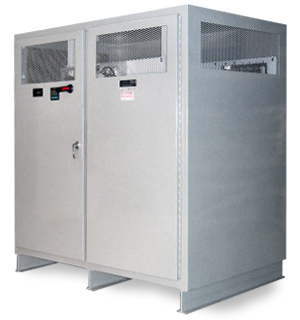 What is the SagFighter?™
What is the SagFighter?™
The UST SagFighter corrects short, deep sags that may be presented to the load by the incoming power system. The power necessary to maintain the load voltage and current in the presence of low input voltage is obtained by drawing additional current from the source. There are no batteries to purchase, maintain, and replace. The SagFighter is always ready to correct a sag, independent of how long it has been since the last sag or how much power has recently been drawn from the system. The SagFighter does not disconnect from the source when a sag is detected and will provide continuous power to the load. Typically, voltage will be restored to above 90% of nominal within 2 milliseconds. The input current necessary to support the load when the input voltage is at the minimum rated voltage (60 % of nominal) for the SagFighter is 1.8 times the nominal current. The long time protective trip function of circuit breakers will allow the current to be 1.8 times the long time trip level for longer than the 100 Second rating of the SagFighter before tripping.
How Does the SagFighter Compare to a UPS?
A UPS normally draws AC power from the incoming power system, and switches to battery power when low incoming voltage is detected. The batteries must supply the entire load power during a low voltage event and usually the UPS continues to operate from the battery source for a pre-determined period of time after the incoming voltage has recovered. The batteries must be sized and maintained to have adequate capacity to support the load until a generator source can be connected or a controlled shutdown can be accomplished. Each time the UPS switches to battery power, the life and capacity of the batteries is degraded. If the incoming voltage sags many times a day, the battery life and capacity may be reduced by a factor of 2 or more, and the batteries may be at a low level of charge when a subsequent sag occurs. Batteries are expensive and must be recycled as hazardous material when replaced.
Some UPS systems employ a transfer switch to transfer to and from battery. Depending on the design of the UPS and the transfer switch, there may be a period of time when the source is disconnected from the load during a transfer. This may or may not be acceptable to the load.
SagFighter, UPS and Motors
A motor draws a higher than normal current (inrush current) during start-up. The amplitude and time duration of the inrush current are determined by factors including the design of the motor, the inertia of the load, the possible presence of a soft-start motor starter or VFD, and the impedance of the power source. The inrush current can be as high as 8 times the full load rated current draw of the motor. The SagFighter is capable of supplying the inrush current necessary to start the motor, although it cannot correct a sag while simultaneously providing more than rated current.
Most UPS systems cannot provide adequate inrush current to start a motor unless the inrush is carefully mitigated by a soft-start or the UPS is oversized. The UPS will likely register an overcurrent fault and reduce its output voltage or shut down entirely. The motor will not start under these conditions.
Many motor loads operate from a Variable Frequency Drive (VFD). VFDs are sensitive to input voltage and will shutdown when the input voltage is less than approximately 90% of nominal or when input voltage is disconnected. A SagFighter will condition the voltage to the VFD such that sags caused by parallel loads do not cause the VFDs to shut down.
UPS Advantages
A UPS will provide power to its load for a period of time during a power interruption, allowing a seamless transition to a backup generator or a controlled shutdown, within the capacity of the batteries.
SagFighter Advantages
The SagFighter does not have the stored energy necessary to ride through an interruption. Power Studies show that more than 95% of voltage-induced loss of production is caused by sags, and less than 5% are caused by shutdowns. The SagFighter provides a much less expensive solution to the sags (95% of events) than a UPS and backup generator.
The SagFighter actual efficiency is greater than 99%, resulting in lower operating and thermal management costs than an equivalent UPS.
The UPS is expensive to maintain and may have actual operating efficiency (at actual input voltage and current draw) or less than 95%, resulting in higher power cost and requiring a higher capacity cooling system.

